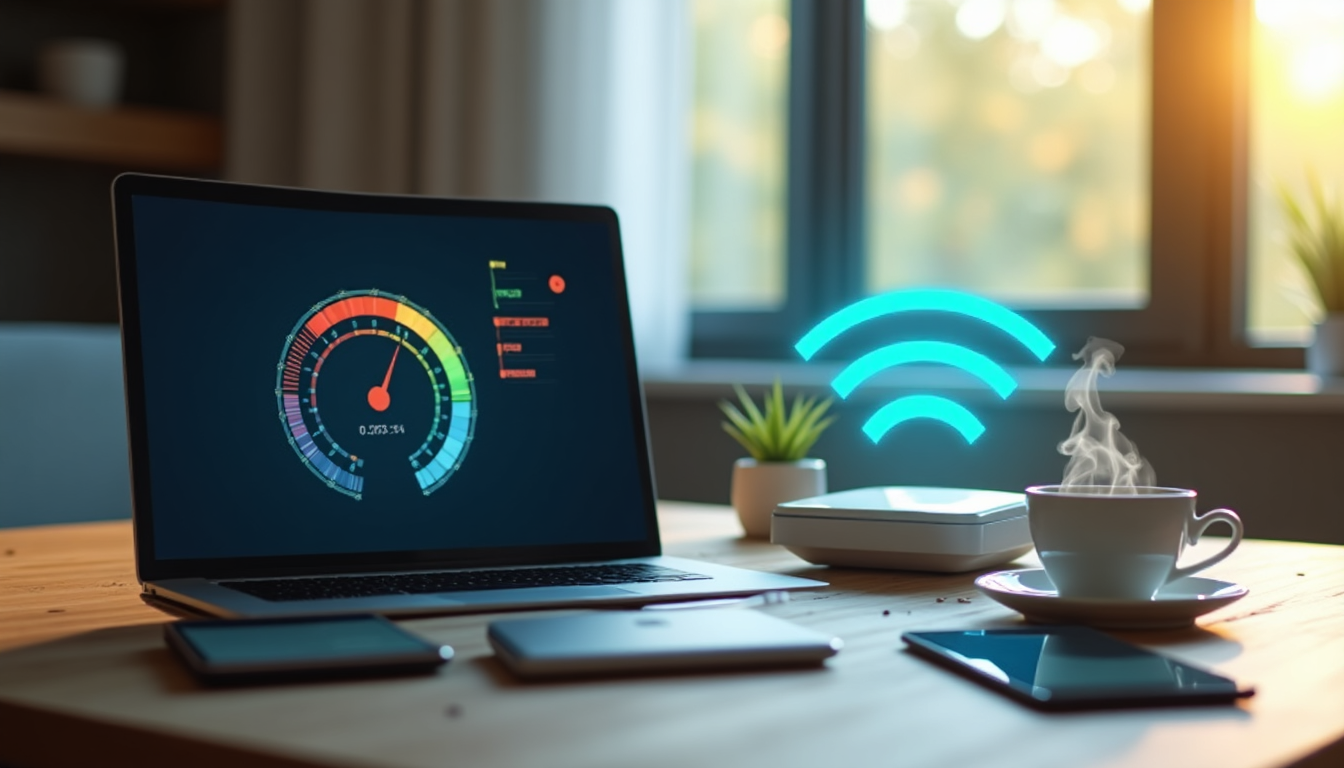How to Perform a Speedtest for Wifi: A Step-by-Step Guide

Poor internet speeds can ruin video calls, create streaming buffers, and make online games lag. A Speedtest For WiFi lets you check your actual connection speed and see if your Internet Service Provider (ISP) delivers the service you pay for. This tool measures everything in internet performance, including download and upload speeds.
This complete guide shows you the right way to test your WiFi speed. You’ll understand key metrics like Mbps, latency, and jitter, and find the best ways to get accurate results. The guide also helps fix common connection problems. You’ll get all the details you need to verify your connection works well for Netflix streaming or remote work.
Understanding WiFi Speed Tests
A WiFi speed test helps measure your internet connection’s immediate performance through nearby test servers [1]. Sample files download and upload in a controlled environment to simulate real-life online activity and record performance metrics [1].
The speed test measures these essential components:
Download Speed: Determines how quickly data transfers from servers to your device, measured in megabits per second (Mbps) [2]
Upload Speed: Measures data transfer speed from your device to the internet, which is vital for video calls and file sharing [2]
Ping (Latency): Shows your connection’s response time, measured in milliseconds (ms) [3]
Jitter: Reveals variations in data transmission speeds that can affect streaming quality [2]
Results can vary based on location and time of day, so running multiple tests provides better accuracy [1]. Speed tests give approximations rather than exact speeds [1]. Your device’s capabilities, router limitations, and server locations can affect test results [4].
Understanding speed measurements helps interpret results better – 1,000 Mbps equals 1 Gbps (Gigabits per second) [1]. Modern applications like video conferencing and cloud storage make upload speeds as important as download speeds [1]. Users should close any bandwidth-heavy applications before starting a speed test to get the best results [1].
Preparing for Your WiFi Speed Test
Proper preparation will give you accurate WiFi speed test results. You should take several steps to optimize your testing environment before starting any test.
A restart of both modem and router helps clear temporary issues and gets the equipment working at its best [5]. Make sure to disconnect all devices from the network except your testing device – this includes wireless security cameras, smart speakers, and mobile phones [5].
These preparations will give you the best testing results:
Clear browser cache and close all background applications [1]
Use an Ethernet cable to connect directly to the router if possible [7]
Close all streaming services and automatic downloads [7]
Put unused mobile devices in airplane mode [5]
The best results come from tests done in different conditions. Test speeds at different times during the day since peak hours (usually weeknight evenings) can affect speeds by a lot [8]. Tests at different distances from your router will help find potential coverage issues [8].
Your mobile device’s WiFi technology might limit test results. A smartphone that uses 2.4 GHz 802.11g WiFi can’t measure speeds beyond 150 Mbit/s, even with faster service available [9]. The most accurate results come from newer devices that can handle your target data rates [9].
Step-by-Step Guide to Performing a WiFi Speed Test
You can test your WiFi speed easily with popular online tools. Let me show you how to get accurate results:
Choose a Testing Platform
Check trusted sites like Speedtest.net by Ookla or simply search “internet speed test” on Google [10]
Start the Test
Click the “Go” or “Begin” button to start [11]
Keep your device still while the test runs [11]
Make sure your device stays connected to your WiFi network [11]
Monitor Results
Your test will measure download speed first, then upload speed [12]
You’ll see ping (connection response time) and jitter (speed fluctuation) numbers [12]
Getting a full picture of your connection needs multiple tests at different times. Network traffic and nearby WiFi signals can affect your results [11]. Your speed test might show numbers slightly below what your Internet Service Providers (ISPs) advertise. This is normal, but speeds should stay within 50 to 200 Mbps of your paid plan [13].
Mobile users can download apps like Ookla’s Speedtest or the FCC Speed Test app that offer extra features and video quality checks [10]. If you’re a gamer, your console’s network settings menu has built-in speed tests to measure gaming performance [10].
Troubleshooting Common WiFi Speed Issues
Slow WiFi speeds can frustrate anyone, and several common problems might be at fault. Your network gets congested at the time multiple devices fight for bandwidth, especially when you have peak usage hours [14]. Walls and appliances can weaken WiFi signals, and where you place your devices can affect performance by a lot [15].
These simple solutions can fix common speed problems:
Keep your router’s firmware up to date to make it work better and fix bugs [16]
Put your router in a central, raised spot with no obstacles around [15]
Think over using a WiFi extender in areas with weak or no connection [16]
Disconnect devices you don’t need to reduce network traffic [17]
Old hardware can limit your connection speeds by a lot. All but one of these older router models can’t deliver Gigabit+ speeds [16]. Loose or damaged networking cables can weaken internet signals or cause complete bandwidth loss, so check them if you keep losing connection [18].
Security software and VPNs might slow down your connection without you knowing it. Your firewall and antivirus programs scan data for threats all the time, which can slow things down [16]. VPNs protect your privacy but might reduce upload speeds because they encrypt your data [19]. Gamers should note that high ping (over 130ms) creates noticeable lag and hurts performance [4].
Speed problems that persist after simple fixes might need your Internet Service Provider’s (ISP) attention. Provider networks often get overloaded during busy hours [18]. On top of that, it helps to run consistent speed tests because ISPs might throttle your connection on purpose [18].
Conclusion
WiFi speed testing is a crucial diagnostic tool that helps modern internet users learn about their connection performance and what it all means. Users just need to test regularly to check their service quality, spot problems early, and verify if their internet speeds match their subscription plans. A combination of good testing preparation, precise measurements, and understanding of important metrics helps users keep their network running at its best.
Network speed requirements change as technology advances and users just need more bandwidth for their applications. People who become skilled at speed testing understand their connection’s capabilities and limitations better. This knowledge becomes especially valuable when you have to fix problems, upgrade service plans, or optimize home networks for gaming, streaming, or remote work.
FAQs
How do I conduct a WiFi speed test?
To test your WiFi speed, open a web browser on a stationary device such as a computer, phone, or tablet. Navigate to a speed test website like hellotech.com/speed. Click on the “Go” button and allow the test to complete. You may repeat the test if necessary to verify the results.
What constitutes a satisfactory WiFi speed?
Adequate internet speed typically starts at 25Mbps for downloads and 3Mbps for uploads, as per the Federal Communications Commission (FCC) standards for broadband connections. However, for improved performance, consider plans offering download speeds in the range of 40–100Mbps.
How can I check the strength of my WiFi signal?
On a Windows device, access the “Network and Internet” settings, then go to “Network and Sharing Center” and click on the blue WiFi link to view the signal strength. For Mac users, the WiFi signal strength can be seen in the WiFi indicator located in the upper-right corner of the screen on the menu bar.
What are some effective methods to enhance my WiFi speed?
Improving your WiFi speed can be achieved through several methods including updating your browser, conducting virus scans and removal, rebooting your devices, using a WiFi extender, or switching your WiFi channel to avoid congestion.
References
[1] – https://www.pilotfiber.com/blog/speed-tests
[2] – https://fiber.google.com/speedtest/
[3] – https://www.ookla.com/resources/guides/speedtest-methodology
[4] – https://www.speedtest.net/about/knowledge/faq
[5] – https://www.imon.net/imon-difference/news-events/tips-performing-accurate-internet-speed-test
[6] – https://www.pcmag.com/how-to/how-to-check-your-internet-speed
[7] – https://www.newsweek.com/vault/home-services/internet/best-internet-speed-tests/
[8] – https://www.cnet.com/home/internet/best-speed-tests/
[9] – https://kb.veexinc.com/en/knowledge/what-tool-or-instrument-is-used-to-test-internet-speed
[10] – https://www.wired.com/story/how-to-test-wifi-speed/
[11] – https://www.hellotech.com/blog/how-to-test-your-wifi-speed?srsltid=AfmBOopr09h8X25oFM8-og9wkZwgaerWVqHpgFydxROjHflysaQy-H
[12] – https://support.google.com/fiber/answer/6032574?hl=en
[13] – https://www.testmyspeed.com/insights/internet-speed-test-results-explained
[14] – https://www.ookla.com/articles/guide-to-speedtest-metrics
[15] – https://support.microsoft.com/en-us/topic/10-tips-to-help-improve-your-wireless-network-d28bf4e4-cf8c-e66f-efab-4b098459f298
[16] – https://www.astound.com/learn/internet/optimize-wifi-speed/
[17] – https://www.avg.com/en/signal/why-is-my-ping-so-high
[18] – https://www.highspeedinternet.com/resources/why-is-my-internet-so-slow
[19] – https://race.com/blog/internet-upload-speed-slow/

